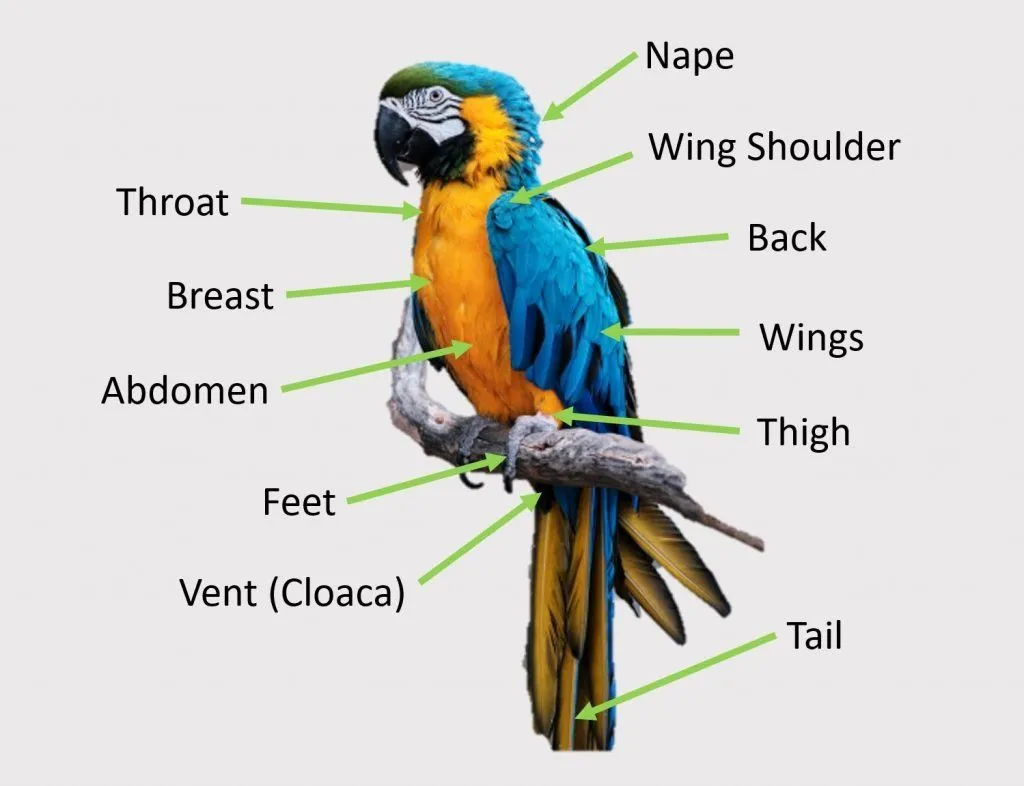The Anatomy and Physiology of Sun Conures | The Body of a Sun Conure: An Inside Look | A Beginner’s Guide to Sun Conure Anatomy and Physiology | The Body of a Sun Conure: An Inside Look.
Introduction.
We know that sun conure comes in different varieties. Sun conures are not just beautiful pets they are also curious to learn about them. all different varieties of parrots have different Anatomy and Physiology. Some parrot is long, small, big, and Strong.
Anatomy.
Anatomy is what helps us understand the structure of the body. It involves learning about the shape, size, and relationships of body parts, such as organs, tissues, and cells. Anatomy tells us what a body looks like.

Indeed, there are many parts to anatomy, but I’ve provided information about a few specific aspects here.
These Are Anatomy Parts Of Conure Parrot
| 1. Size |
| 2. Beak |
| 3. Eyes |
| 4. Wings |
| 5. Tail |
| 6. Feet |
| 7. Digestive System |
| 8. Respiratory System |
| 9. Plumage |
| 10. Ears (Internal) |
1. Size.
Sun conure birds come in different sizes, small to medium-sized, Parrots come with a compact body structure.
They typically measure around 12 inches (30 centimeters) in length, including their tail feathers. Their small size permits them to move quickly through their surroundings.
2. Beak.
The beak of a sun conure is a nice feature, This is a strong and hooked structure. It consists of an upper and lower mandible.
it’s used for cracking open seeds like nuts and manipulating different food items. The break is important for their feeding habits.
3. Eyes.
All we know Eyes is how important in daily life for humans and also for birds. Sun conure has relatively large, round eyes.
Which are fit for their needs. They can see anything in their food and detect potential predators in their surroundings.
5. Wings.
Sun conure or any bird takes the help of wings to fly and attack small insects.
conure birds have well-developed wings that look change to their body size. These wings are strong and designed for wonderful flight.
6. Tails.
Sun conure birds have different sizes of tails some birds have a little longer or sort. mainly male sun conure have longer tails around 5.15 to 5.74 inches.
They have different structures of their tails and females have small tails around 4.76 inches and can also grow as long as 5.74 inches. both are approximately looking the same.
Physiology.
Sun conure has unique and different types of color, have wonderful Physiology that helps them thrive in their natural habitat and adapt to life as pets.
Their physiology includes various like how they breathe, digest food, and even show off their beautiful plumage.


These Are Physiology Things.
| 1. Breathing and Energy |
| 2. Digestion and Nutrition |
| 3. Plumage and Communication |
| 4. Skeletal System |
| 5. Reproductive System |
1. Breathing and Energy.
Just like a human takes a breath to live long, sun conure also needs oxygen to live. They have a unique respiratory system that involves air sacs, allowing them to absorb oxygen.
This system makes them strong and helps birds when flying and their strong wing muscles and efficient breathing make them agile flyers.
2. Digestion and Nutrition.
Sun conure has a digestive system that is good at processing various foods. They enjoy fruits, seeds, and vegetation.
They use strong beaks to break seeds or open seeds and they manipulate or grind the food. when it comes to feeding their babies, a process called crop feeding.
This ensures their little small birds get the nutrients to grow up. A
3. Plumage and Communication.
The plumage helps for the strong catch of both wings of birds. sun conure has rangin’ feathers that occasionally help to hide in any thickets from dangerous birds or different dangerous things.
these feathers help them to talk with other birds and sow their colorful feathers to attract mates during courtship displays.
4. Skeletal System.
The skeletal system of a Sun Conure bird is characterized by lightweight and hollow bones that aid in flight.
Their keel, a prominent extension of the breastbone, provides support for the powerful flight muscles. Fused neck vertebrae offer stability during head movements, while elongated wing bones enable wing movement.
Sturdy leg bones are designed for perching, and the skull is lightweight and fused to protect the brain and support the beak.
This specialized skeletal adaptation allows Sun Conures to fly gracefully, perch securely, and thrive in their avian lifestyle.
5. Reproductive System.
The Sun Conure’s reproductive system is typical of many birds. Females have ovaries where eggs develop and a single oviduct where fertilization occurs.
Males have testes for sperm production. During the breeding season, Sun Conures engage in courtship and, if a pair forms, copulation.
Females lay eggs in nests, often in tree cavities or nesting boxes, where they incubate them. Both parents take turns incubating the eggs, and after hatching, share chick-rearing duties, including feeding and care.
FAQs.
1. What makes the Sun Conure’s plumage so vibrant?
Ans: The vivid colors of Sun Conure plumage are due to pigments called carotenoids found in their diet. These carotenoids are metabolized and deposited in their feathers, creating their striking appearance.
2. How do Sun Conures use their beaks in their daily lives?
Ans: Sun Conures use their strong and hooked beaks for various activities, including cracking open seeds and nuts, manipulating food items, grooming their feathers, and even as a tool for climbing and exploring their environment.
3. Why is the respiratory system of Sun Conures so important?
Ans: The unique respiratory system, including air sacs, is crucial for their high-energy activities like flying. It allows for efficient gas exchange, ensuring they have the oxygen needed for their active lifestyle.
4. How do Sun Conures communicate with each other?
Ans: Sun Conures communicate through vocalizations, body language, and their vibrant plumage. They may use calls to alert others to potential threats or to signal excitement or contentment. Their colorful feathers are also used in courtship displays and social interactions.
5. How do Sun Conures maintain their vibrant plumage?
Ans: Sun Conures engage in preening, which involves cleaning and arranging their feathers with their beaks. This helps keep their plumage in excellent condition, allowing them to display their bright colors effectively.
Recommended Post.
All About Red Factor Sun Conure
